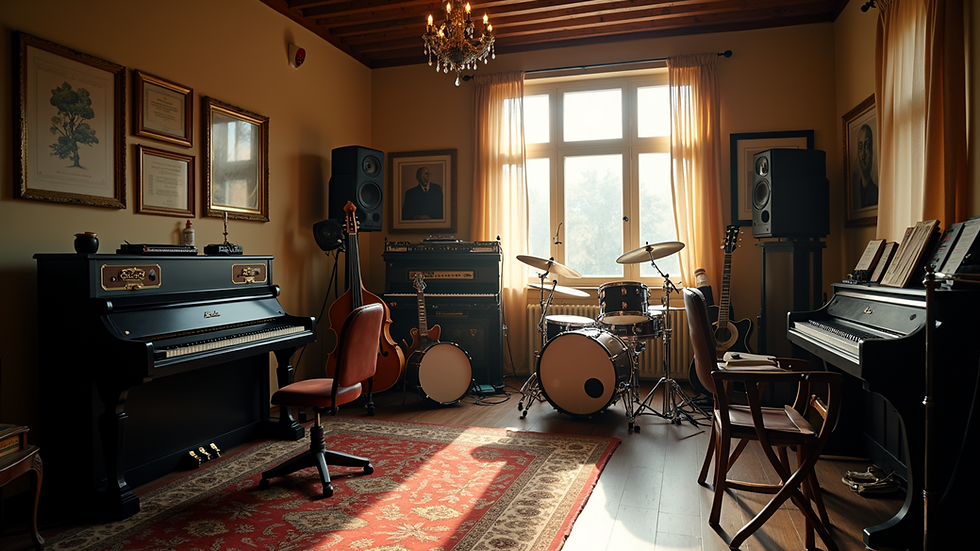Exploring the Art and Science Behind Producing Music
- Gorilla Mode Entertainment
- May 14
- 4 min read
In today's digital age, producing music has become a captivating blend of art and science, captivating both amateur creators and seasoned professionals. Whether you dream of becoming the next big artist or simply want to explore your passion, understanding the intricacies of music production can empower you to express your creativity effectively. This blog post will delve into the various elements that shape the music production process, guiding you through techniques, tools, and tips that will bring your musical ideas to life.
The Essentials of Music Production
Music production encompasses several phases, from songwriting and arranging to recording, mixing, and mastering. It’s an exciting journey that combines creativity and technical skills. Each step plays a crucial role in turning a raw idea into a polished track.
1. Songwriting and Arranging
At the heart of every great piece of music is the songwriting process. This is where the initial idea begins to take shape. Whether it’s a catchy melody, a poignant lyric, or an intricate chord progression, effective songwriting allows you to express emotions and connect with your audience.
Melody and Harmony: Begin by creating a melody that resonates with the mood of your song. Use a piano or guitar to experiment with different chord progressions that complement your melody.
Structure: Common song structures include verse-chorus-verse or A-B-A. Keep in mind that a well-structured song is easier to follow and more engaging for listeners.

2. Understanding Music Production Tools
As you move forward with your creativity, understanding the tools and software available for music production is essential. Digital Audio Workstations (DAWs) serve as the backbone for most music production tasks. Popular DAWs include Ableton Live, FL Studio, and Logic Pro X.
DAW Features: Look for user-friendly features such as built-in instruments, plugins, and audio effects.
Plugins and Virtual Instruments: These can enhance your sound and provide a diverse array of audio options. Popular plugins include Serum for synthesizing sounds and FabFilter for mixing.
Investing in quality headphones and monitors is equally important. This allows you to hear your music accurately, ensuring that your final mix translates well on various playback devices.

How do I start producing music?
Starting your journey in music production can feel overwhelming due to the vast amount of information available. However, breaking it down into simple steps can make the process more manageable.
1. Choose Your DAW
Begin by selecting a DAW that fits your workflow and style. Most DAWs offer free trials, so take advantage of these to see which one feels right for you.
2. Learn the Basics
Once you've chosen a DAW, familiarize yourself with its layout and basic functions. Utilize online resources such as tutorials and forums to get a head start. Free websites like YouTube have countless tutorials that cover everything from basic navigation to advanced production techniques.
3. Create Your First Track
Start with a simple project. Choose a genre you like and try to recreate a favorite song. Focus on the essential elements: drums, bass, melody, and harmony. As you gain confidence, explore adding more layers and complexity.
4. Practice Regularly
Like any skill, music production requires regular practice. Set aside dedicated time for your creative sessions. Experiment with different genres, techniques, and sounds to develop your unique style.
5. Seek Feedback
Share your work with friends, family, and online communities. Constructive criticism can provide valuable insights and motivate you to improve.

The Mixing Process
Once you've recorded your music, it’s time to mix it. Mixing is the art of balancing various audio tracks to create a cohesive sound. Here are key techniques to keep in mind:
1. Balance Levels
Start by adjusting the volume of each track to create a balanced sound. This includes ensuring vocals can be heard over instrumentals while maintaining clarity.
2. Panning
Panning involves placing sounds within the stereo field, helping to create space in your mix. For example, you may pan rhythm guitars left and right to create width.
3. EQ and Compression
Equalization (EQ) allows you to boost or cut specific frequencies, shaping the overall sound. Compression helps regulate dynamic differences between sounds, making your mix sound polished.
4. Reverb and Effects
Adding reverb can create an atmosphere around your mix. Experiment with various effects to enhance vocals or instruments, but use them sparingly to avoid clutter.
Mastering Your Track
Mastering is the final step in the music production process and is essential to delivering a professional sound. It involves preparing and transferring the final mix onto a format for distribution. Here’s how to master your track effectively:
1. Begin with a Reference Track
Listen to a professionally mastered track that is similar in style to yours. This will help you gauge the overall loudness and tonal balance.
2. Use Limiting Wisely
A limiter increases the overall volume of your track without distortion. Be cautious, though—excessive limiting can strip your music of its dynamics.
3. Sparingly Apply EQ
Use EQ during mastering to make subtle adjustments and ensure a cohesive sound across different playback systems.
4. Listen on Various Systems
Test your master on speaker systems, headphones, and different devices. Each playback system has unique characteristics, and it's crucial to ensure your track sounds good across all of them.
Your Path Ahead
Becoming proficient in producing music involves blending creativity with technical knowledge. The art of music production is an ongoing journey, one that evolves as you continue to learn and practice. Embrace the challenges, celebrate your successes, and most importantly—enjoy the process of creating music that speaks to you and others.
By exploring the steps detailed in this post, you're empowered to embark on a rewarding path in the world of music production. Remember, every producer started as a beginner, so nurture your passion and keep creating!




Comments